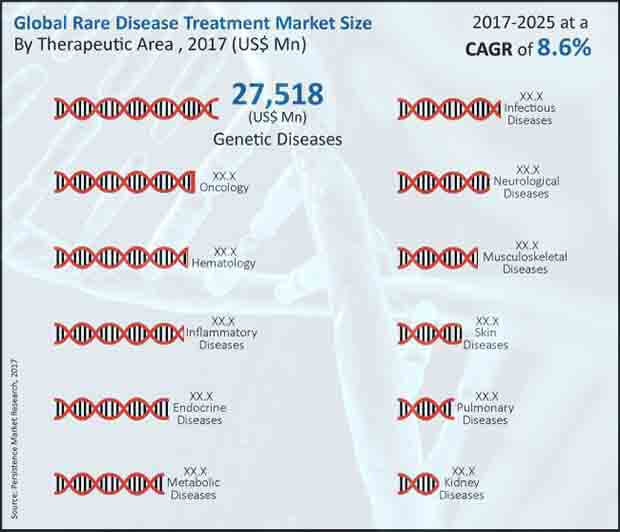Rare Disease Treatment Market 2022
A comprehensive evaluation presented by Persistence Market Research on the global rare disease treatment market in a new research report titled “Rare Disease Treatment Market: Global Industry Analysis 2012 – 2016 and Forecast 2017 – 2025” highlights the performance of the various segments in the market over a period of eight years. This involves the current scenario of the market dynamics along with the forecast of the entire market across various geographies. According to Persistence Market Research, there are many opportunities that promote revenue growth in this market during the forecast period.
Get Sample Copy of this Report@ https://www.persistencemarketresearch.com/samples/12862
The report covers important geographies of North America, Latin America, Europe, Asia Pacific and Middle East and Africa. Of these major landscapes, North America lays a significant growth track to show a value of US$ 78,434 Mn by the end of 2025 according to forecast insights in the research study. Following North America, Europe and Asia Pacific, especially Japan, are in line showing potential for the treatment of rare diseases over the period of eight years. The Middle East and Africa region (MEA) will depict sluggish growth owing to low awareness of rare diseases and hence their treatments.
Company Profiles:
- Novartis AG
- Pfizer Inc.
- F. Hoffmann-La Roche Ltd.
- Celgene Corporation
- AbbVie Inc.
- Johnson & Johnson Services, Inc.
- Shire
- Alexion
- Novo Nordisk A/S
- Sanofi
- Bayer AG
- Amgen, Inc.
- Allergan plc.
- Eisai Co. Ltd.
- Bristol-Myers Squibb Company
- Merck & Co., Inc.
- Vertex Pharmaceuticals
- Baxter
- BioMarin
- Teva Pharmaceutical Industries Ltd.
- Others
Request for Methodology@ https://www.persistencemarketresearch.com/methodology/12862

Several opportunities lurk around the market, creating a positive impact on global market growth rate
Acquisitions across the global scenario can be used to expand the business portfolio and operations of key players, who will do well to leverage this strategy to establish a global footprint. Forward integration can be achieved by expanding the value chain. The operating efficiency should be increased to achieve high return on investment. This can be achieved by shifting the manufacturing of important medicines to orphan drugs.
The manufacturers of orphan drugs are enjoying the advantages of tax benefits, fast approvals and other research grants, thereby making room for more innovations. Product innovation can lead to advanced therapeutics and innovations in medicine or drugs, which can be used to tap new markets. Moreover, the increasing incidence of rare diseases gives a plus to the market.
The public is aware of these rare diseases and this awareness is rising owing to government effort and other social groups. Adding to this scenario, the reimbursement schemes in developed economies are pushing the growth in demand for rare disease treatments and thereby fueling the rare disease treatment market growth in developed countries.
Access Full Report@ https://www.persistencemarketresearch.com/checkout/12862
Global Rare Disease Treatment Market: Segmental Forecast
The global rare disease treatment market report involves a five level segmentation comprising – by therapeutic area, by drug type, by drug class, by mode of administration and by distribution channel.
- The genetic diseases segment by therapeutic area, which was dominating the global market in the past will show similar traction in the next eight years. This segment is anticipated to be valued at US$ 56,241 Mn by the end of 2025. The metabolic diseases segment by therapeutic type shows higher growth rate as compared to the genetic disease segment and is poised to reach a value of US$ 23,938 Mn by 2025 end
- By drug type, originator drugs is the largest segment in the global rare disease treatment market, estimated to hold about 75% market share by 2025 end
- Of the various drug class segments, organic compounds is the dominant and most attractive segment, with attractiveness index of 0.6 during the forecast period
- The oral segment by mode of administration dominates the global market for rare disease treatment from a revenue standpoint and is forecasted to continue this trait throughout the period of forecast. It has the highest market attractiveness index of 2.2. The injectable segment is poised to account for a value share of 39.5% by 2025 end and reflects a market attractiveness index of 0.8
- By distribution channel, specialty pharmacies segment dominated the global rare disease treatment market in revenue terms in 2016 and is projected to continue to do so throughout the forecast period. Specialty pharmacies is the most attractive segment, with attractiveness index of 1.6 during the forecast period
About Us: Persistence Market Research
Contact Us:
Persistence Market Research
Address – 305 Broadway, 7th Floor, New York City, NY 10007 United States
U.S. Ph. – +1-646-568-7751
USA-Canada Toll-free – +1 800-961-0353
Sales – sales@persistencemarketresearch.com
No comments:
Post a Comment